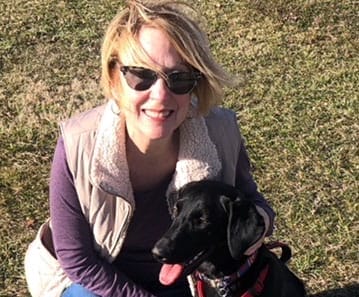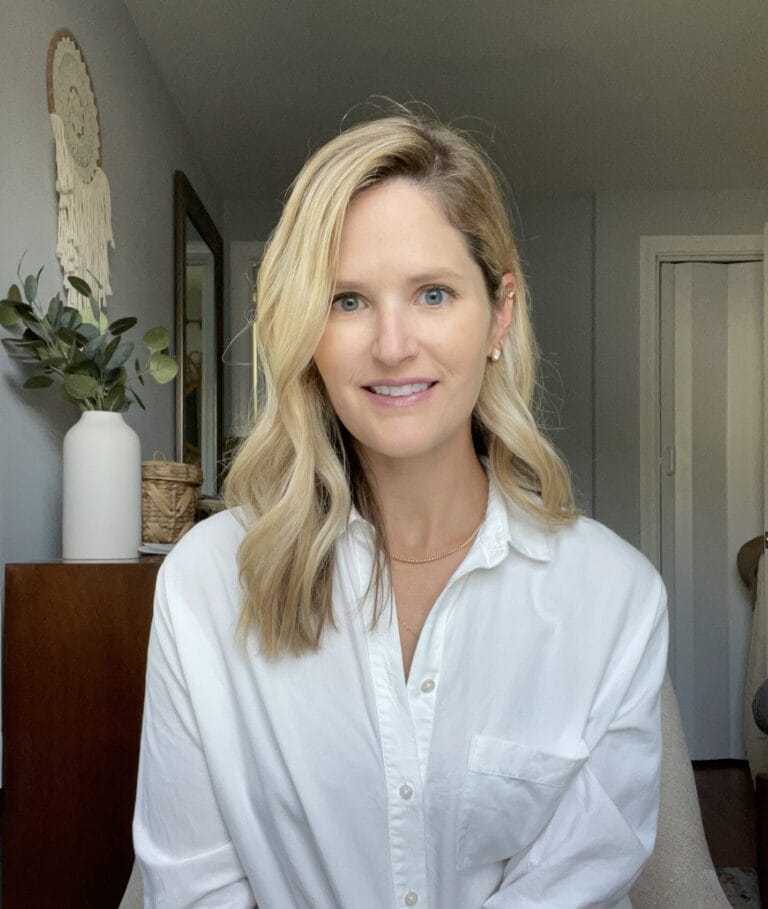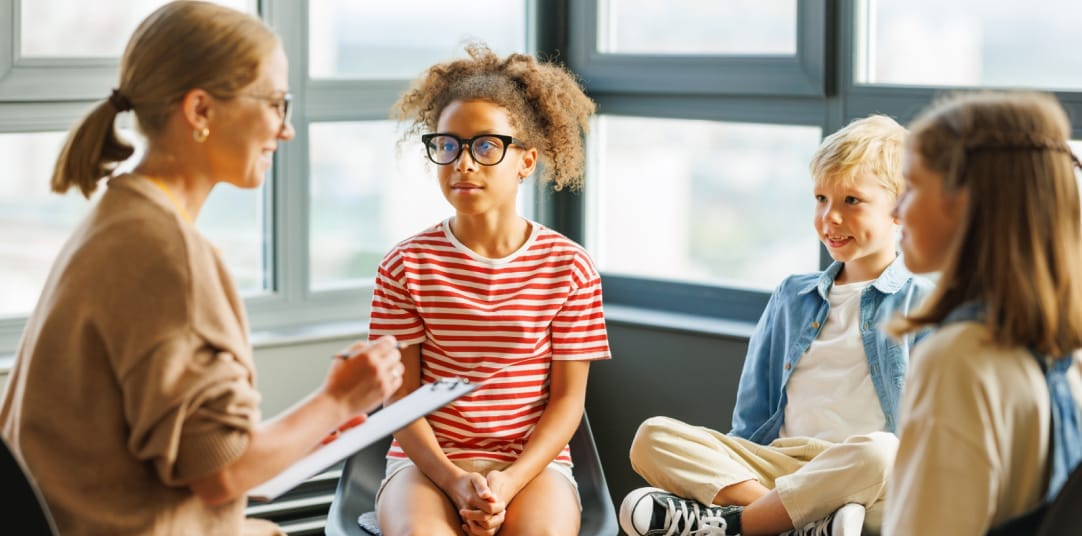

Kimbra K. attended Cal State Fullerton and worked for Anaheim school districts for several years. She moved to Washington state seeking a different lifestyle with her husband and worked there for about 15 years. While living and working in Washington, she met a woman who specialized in working with students with behavior problems and dogs. Through this relationship, she discovered animals and kids with issues are a perfect match. Kimbra describes her passions outside of her therapy work as her animals—in addition to dogs, she has horses and donkeys. Kimbra and her husband are very outdoorsy—they love to go hiking and camping, and they do lots of kayaking on the rivers where they live.
We’d love to hear about your therapy practice with children and dogs.
The very first time I ever had a session with a dog, I had a little 3-year-old. Everyone at the school said the child wouldn’t talk. I thought to myself, “Oh, I can get him to talk with my puppets, my cars, my trucks.” I couldn’t get that child to talk. So I called the mom. She told me, “Oh, he talks all the time. I don’t know what the problem is.” One of my Para educators suggested I bring my dog Rainbow. Rainbow was a Basset Hound and Pitbull mix—that was 25 years ago, before anyone even thought about bringing dogs to school. So I brought Rainbow to school with me and that little kid wouldn’t stop talking. I thought “OK, there’s something to this.” I figured I broke the ice, there’s no problem. So the next session I didn’t bring Rainbow and the only thing the child said was “Where’s Rainbow?”
Rainbow started coming to the preschool every week with me. And as time went on and the evaluation proceeded, we discovered that this child had witnessed violent acts towards his mother and didn’t trust strangers. Rainbow became the bridge with the classroom teachers and the parent educators to get him to trust people. After that, I started using Rainbow with all my young students who needed motivation to speak—kids with autism, low-verbal kids, attention-challenged kids.
As time evolved, I was transferred to secondary and got another therapy dog named Cali, a German Shepherd/Border Collie mix. I started working with kids in the emotionally disturbed program. Cali became my lifeline. A friend of mine who was a dog trainer and I combined our skills. We developed a formalized program. The school district started hiring her to come in and we would co-facilitate these lessons working on the social skills, pragmatics, problem solving, big time impulse control.
My whole career as a speech-language pathologist has been enmeshed with using animals as co-therapists. I moved to Missouri in 2007. By this time, the laws and regulations had changed. I’ve never been without a therapy dog. By then I had Cinch, a purebred Australian Shepherd. For the first time, he became formally certified as a therapy dog. Missouri was very open. Cinch just passed away last year. He worked with me for 11 years, even with kids with augmentative communication devices who we couldn’t get motivated. Bringing Cinch into the mix changed everything. The teachers have told me, “The days that you and Cinch are not here are torture because that’s all they’re doing on their devices.” So it does have that drawback.
Now I have Luna. Luna was in training to be my next therapy dog but then COVID-19 hit so that’s on hold for now.
What have been some of the most significant challenges you have faced in your teletherapy practice and how have you worked to overcome these challenges?
The most challenging aspect has been working with the two students who have characteristics of selective mutism. Thanks to my therapy dog, Luna, we were able to have breakthroughs. These two students, I tried so many different activities, and couldn’t get anywhere. It was the one therapy I was regretting because it was just so challenging. And then I thought “Duh, why don’t I try my dog? I would use Luna in school with these kids.” This is an area that for some reason I didn’t even think about it.
Because Luna knows a lot of different tricks, I wrote a little chart with a list of all the things that Luna could do. And then I created another column that said “Do you want me to do the tricks with a treat or without a treat?” My goal was just to even get them to read. One of the students opened up so much he not only read it, he started spontaneously asking me to do things. My other student, the one that has really profound selective mutism, started circling what he wanted me to do with Luna. But because I had to move out into the room so they could see, I intentionally asked them, “I can’t tell if you guys can see. Can you tell me yes or no?” He was starting to say “Yes,” or “No, I can’t see her.” So I was starting to get verbalizations for the first time, for the very first time! Then at the end when we were talking about what trick do you like best, the student with selective mutism actually verbalized the trick. It was a huge breakthrough.
Then in the next sessions with the one student—this has opened up some doors for him. The other one is now reading to me the tricks. So he’s gone from circling to reading the tricks. I’m still getting one to two word phrase responses. Then he even told me using thumbs up and thumbs down that he has a dog he wants to train. He wants me to teach him how to train his dog. So I am hoping that when we get to this point, he’ll have to use verbalizations—sit, stay, down. We are having exchanges and talking about something now. Whereas before, I couldn’t get any conversations going. So now I use Luna.
I have another student—we’re working on the zones of regulation. I used Luna as a demo dog to demonstrate keeping yourself out of the red zone, out of the yellow zone, and in the green zone. Luna goes nuts if I bring treats. She won’t listen. She’s all over the place. I intentionally brought treats into the session, knowing she’d start going ballistic. I was modeling to him—”Ok, I am feeling very annoyed and irritated so I think I’m going to breathe.” I’m modeling and showing how I got myself back into the green zone and then the problem solving. So we had a whole discussion about the zones. “What would have happened with Luna and I if I’d gotten into the red zone and I started yelling at her?” It was a student who had been zone-regulationed out. Initially, he had the stance, “Oh, I know those zones.” It was just a different way to get him engaged. We’re building on that now.
It doesn’t have to be a trained therapy dog. It can be any dog. I am fostering a dog named Rusty. I have this little boy that doesn’t know he, his, and him. He has a lot of attention issues. I took old Rusty out and got his leash, his bowl. “Here’s Rusty, he is a dog. Look. Here’s his bowl. Here’s his leash.” I had him imitating. “I think I need to get him.” He just loved it.
I am so focused on how much these dogs are helping the kids, I forget these dogs help me as a therapist. They make my job less stressful, more enjoyable, and more interactive. In some ways working with a dog is harder because they bring unexpected things to a session and you have to be able to improvise in the moment. For example, yesterday, we had an ice storm. I asked the child if he’d like to see Rusty’s backyard. “Let’s go see his backyard and then you can see the ice.” I let Rusty out and then I couldn’t get the darn dog back into the room. It’s 10 degrees here, freezing cold. “OK, I’m going to get his leash, and I’m going to bring him inside.” It got a little bit crazy. You learn to be spontaneous.
When you look at studies for memory, one way to facilitate memory is having emotional experiences. With these students, when I would bring Cinch into the room, it’s not a cognitive activity. It’s an activity that they internalize because they are experiencing it themselves.
I could go on and on. I can’t say enough about animal-assisted therapy.
Let’s back up a little now. What inspired you to become an SLP?
When I was in graduate school, I started out wanting to be a general education teacher teaching public speaking. A very wise man said to me, “Whatever job you do, get something you love doing because it will never seem like work.” From kindergarten on, I was always getting in trouble for talking. I just love to talk and I love people and interacting. That’s why I was going to become a teacher in public speaking.
I took a course in speech disorders by Dr. Glyndon Riley—he developed the Stuttering Severity Instrument and is renowned for his work in disfluency. I took that class and that was my hook. I thought, “This is it!” It was the best combination—I love to speak, interact, the sciences, the clinical aspect. I never ever once have become tired of what I do.
What made you want to be a teletherapist with PL?
I retired from the public school system, but wanted to continue being a speech therapist as my desire to work with students had not waned, but I did not want to do in person therapy due to COVID-19. Working as a PresenceLearning therapist was a perfect match allowing me to acquire the best of both worlds by working at home and continuing to do speech and language therapy.
COVID-19 inspired me to retire. I was borderline, asking myself whether I wanted to keep going or retire. Then with COVID-19, with my age and my husband is older and I take care of my 96-year-old grandmother, I thought this would be a perfect time. But I didn’t want to stop working. I realized teletherapy would be the perfect match.
I found out about PL through one of my colleagues who has a friend that is working with PresenceLearning, and she’s also retired. I called her and we conversed, and I thought “Wow, this sounds fabulous.” You have the best of both worlds, setting your schedule, and PL is so flexible with how we can do it—how many days. It gives me that flexibility I need to be able to work but yet still take care of my mother-in-law and other responsibilities.
Could you walk us through your daily routine? A “day in the life of a PL therapist” if you will?
My day as a PL therapist starts out with my morning coffee and an early morning walk. I usually do all my planning for the day prior to my sessions. As I do my therapy sessions, I have the luxury of looking out my window and can see my two donkeys and my horse. In-between sessions, I can love on my dogs, or practice a few tricks with Luna. After my day is done doing therapy, I feed my horses and my husband usually has dinner waiting for me. My husband loves to cook. That’s his hobby. In the evening, we sit, enjoy a glass of wine, talk about the day. We live on 60 acres…in spring and summer we’ll take evening walks, or just sit outside and watch our donkeys and our horse.
I live in Missouri but I work with students in Washington. I’m a morning person so I do all my morning things and then start my day with students around 10:30 or 11 my time. I love it!
What do you enjoy about being a provider with PL?
I enjoy the flexibility it provides with scheduling, the wealth of activities and resources, the online provider community, The Lounge, in which you can have support from your peers at your fingertips, and the ability to be able to support school districts who are struggling to meet the needs of students due to COVID-19.
What were you most surprised about when you made the transition to be a teletherapist?
I was most surprised that the majority of my students were motivated to work with me online and that it was not a significant barrier.
I am teaching and working with 8th and 9th grade students. When you are in a brick-and-mortar school, it is hard enough to get them going and inspired. I probably have put more time into planning and preparation because it is a different format. But yet the majority of these students are thrilled. They remember, they come on time, they want to learn, they’re motivated.
I’ve had a few challenging students, as I mentioned earlier—the one has selective mutism and the other just doesn’t like to talk. They’re both in the same group. With all the different types of activities that I am able to do with these students—I am still coming up with new things. It wasn’t the barrier I’d expected. Just to be honest, about three or four years ago my special education director mentioned and brought up to the SLP team, “Why don’t you start doing teletherapy?” I protested the most. Then with COVID-19, I was one of the first ones to start doing teletherapy with Google Meets. Everyone else was not interested. And I thought, “This is really fun!” I saw that I could make progress with my articulation kids. I have a couple now that have oral motor challenges, and I saw I could do oral motor therapy. There were therapies that were very successful that I could have never guessed. It opened my mind a lot.
How have you been helping parents and caregivers who are now acting as the primary support person with their child?
One thing that has really been an advantage–I’ve been able to have meetings with parents and demonstrate to them how I want them to help their son or daughter. This has been a tremendous asset. A lot of parents are very overwhelmed. I feel like I am more accessible to them. Because we can do video, we can do phone. Another advantage is the meetings. A lot of the parents are having meetings with their work now due to the pandemic. I feel like we’re having 100 percent compliance getting all the parents to the meetings. Parents had not been there. In one sense, I communicate with the parent every week because I’m letting them know “OK, it’s time for your son or daughter’s session.” So that’s been good.
How has the PL online platform enabled you to help your students and the schools you serve in new ways?
I feel that as a PL therapist, I have more parent contact and interaction. When I need to model how to do home practice, it is easy to set up a live session to do so. I can easily navigate meetings as travel time has been eliminated between schools. I have also been able to help the school therapist doing assessments for parents who do not want to bring their children into the school setting due to COVID-19 concerns.
Are you interested in joining the PresenceLearning Care Network? Click here to start your application.




